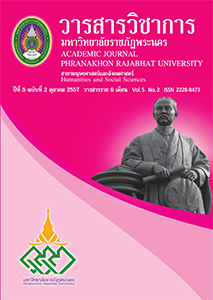การมีส่วนร่วมของประชาชนในการบริหารจัดการ ทรัพยากรนํ้าลุ่มนํ้าป่าสัก
Keywords:
การมีส่วนร่วมของประชาชน, การบริหาร ทรัพยากรน้ำ, Participation, ManagementAbstract
การวิจัยนี้มีวัตถุประสงค์ 4 ประการ 1. เพื่อ ศึกษาสภาพทั่วไปของการบริหารจัดการทรัพยากร น้ำลุ่มน้ำป่าสัก 2. เพื่อศึกษาแนวคิดทฤษฎีและหลัก พุทธธรรมเกี่ยวกับบริหารจัดการทรัพยากรน้ำ 3. เพื่อ ศึกษาปัจจัยที่ส่งผลให้ประชาชนเข้ามีส่วนร่วมในการ บริหารจัดการทรัพยากรน้ำลุ่มน้ำ 4. เพื่อนำเสนอรูป แบบการมีส่วนร่วมของประชาชนในการบริหารจัดการ ทรัพยากรน้ำลุ่มน้ำป่าสัก ระเบียบวิธีวิจัยในการศึกษา ครั้งนี้เป็นแบบผสม (Mixed Research Method) เครื่องมือการวิจัย คือ แบบสอบถาม สัมภาษณ์เชิงลึก และการสนทนากลุ่ม
ผลการวิจัยพบว่า
1) สภาพทั่วไปของระดับผู้มีส่วนร่วมในการ บริหารจัดการทรัพยากรน้ำลุ่มน้ำป่าสักส่วนใหญ่เป็น เพศหญิงจำนวน 215 คน ร้อยละ 53.75 เป็นเพศชาย จำนวน 185 คน ร้อยละ 46.25 มีอายุ18-30 ปีมีจำนวน 158 คน ร้อยละ 39.50 การศึกษาประถมศึกษา 123 คน ร้อยละ 30.75 มีรายได้ตั้งแต่ 3,000-5,000 บาท มีจำนวน 127 คนและอาชีพอื่น ๆ ยังไม่มีอาชีพเป็น นักเรียนและนิสิตมีจำนวน 107 คน ร้อยละ 26.75
2) แนวคิด ทฤษฎี และหลักธรรมอปริ- หานิยธรรมเกี่ยวกับการบริหารจัดการทรัพยากรน้ำ พบ ว่า พระพุทธเจ้าตรัสแสดงแก่เจ้าชาววัชชีผู้ปกครองรัฐ โดยระบอบสามัคคีธรรม สังคมจะไม่แตกแยกสามารถ ใช้เกลี้ยกล่อมมิให้เกิดความแตกแยกขัดแย้งยุติ ความรุนแรงเมื่อนำมาปรับใช้กับการบริหารทรัพยากรน้ำ ป้องกันปัญหาการทุจริตคอรัปชั่นรัฐบาลควรส่งเสริม บรรจุไว้ในนโยบายการบริหารจัดประเทศควบคู่กับหลัก ธรรมาภิบาลซึ่งจะทำให้เกิดความร่มเย็นเป็นสุขต่อไป
3) ปัจจัยที่ส่งผลให้ประชาชนเข้ามีส่วนร่วมใน การบริหารจัดการทรัพยากรน้ำลุ่มน้ำ ให้เกิดประโยชน์ สูงสุดทำให้การบริหารจัดการทรัพยากรน้ำลุ่มน้ำมี ประสิทธิภาพและมีประสิทธิผล พบว่า โดยภาพรวม ทั้งหมด 10 ด้าน อยู่ในระดับปานกลาง (X = 3.20) สรุปได้คือ 1. ด้านคุณลักษณะคุณธรรมของผู้นำ 2. ด้านการให้คุณค่าทางสังคมของสมาชิก 3. ด้านความตระหนักของสมาชิก 4. ด้านความใส่ใจในกิจกรรม ของชุมชน 5. ด้านความเข้มแข็งของชุมชน 6. ด้านการ ได้รับการสนับสนุนและการยอมรับ 7. ด้านกระบวนการ ตัดสินใจ 8. ด้านการรับรู้ข่าวสาร 9. ด้านการกำหนด แผนงานเกี่ยวกับการบริหารจัดการทรัยพากรน้ำำ และ 10. ด้านการบริหารจัดทรัพยากรลุ่มน้ำที่ประชาชนมี ส่วนได้ส่วนเสียควรมีส่วนร่วม
4) ผลองค์ความรู้นำเสนอรูปแบบการมีส่วน ร่วมของประชาชนในการบริหารจัดการทรัพยากรน้ำ ลุ่มน้ำป่าสัก พบว่าได้ 4 รูปแบบคือ 1) การส่งเสริมการ มีส่วนร่วมของประชาชนในการบริหารจัดการทรัพยากร น้ำลุ่มน้ำป่าสัก 2) การส่งเสริมการมีส่วนร่วมของชุมชน ในการบริหารจัดการทรัพยากรนน้ำชุมชนควรดำเนินการ 3) องค์กรภายนอกชุมชนเช่น องค์การบริหารส่วนตำบล เทศบาลองค์การบริหารส่วนจังหวัด กรมชลประทาน กรมทรัพยากรนน้ำ สำนักงานสิ่งแวดล้อมภาค สถาบัน การศึกษา องค์กรเอกชน ควรดำเนินการและให้การ สนับสนุน 4) บูรณาการหลักพุทธธรรมในการบริหาร จัดการทรัพยากรน้ำ
People’s Participation in the Water Resource Management in the Pasak River Basin
The objectives of this research were to 1) study general condition of Pasak River basin water resource management, 2) study concept, theories and Dhamma principles about water resource management, 3) study factors affecting people’s participation in water resource of Pasak river basin management, and 4) present an approach to people’s participation in water resource management of Pasak river basin.
The research methodologies were mixed method of quantitative and qualitative methods. Quantitative research method applied survey research, collecting data with questionnaires from 402 samples of populations who lived in provinces and who involved with water resource management. Data were analyzed by frequency, percentiles, mean, standard deviation and t-test Qualitative research collected data from 21 key informants who were purposefully selected with In-Depth-Interview, and from focus group discussion with 12 specialists, purposefully selected. Data from In-Depth-Interview and focus group discussion were analyzed by Content Analysis Techniques.
Findings were as follows:
1) In general, the participants in the water resource management of Pasak river Basin were 215 females (53.75%), 185 males (46.25 %) 39.50 per cent with ages of 18-30 years old. As for education, 123 persons (30.75 %) with primary education level. 127 persons had income of 3,000-5,000 baht per month and the rest of 107 persons (26.75) were without occupations and incomes and students.
2) The doctrine of water resource management was the seven aparihaniyadhamma. This principle was found the Load Buddha had addressed to the king of Vajji who governed the state with the samaggi-dhamma system, “the society will not encounter with disharmony because the principle prevented the society from disunion and violence.” When it was applied with water resource management, it prevented corruption; therefore, the government should promote and entitled into the policy of good governance-based country administration in order to establish peaceful and happily society.
3) Factors affecting people to participate in water resource management of Pasak river basin for higher benefits, efficiency and effectiveness were that all ten aspects were at moderate level with the average of 3.20 These findings could be concluded as follows; 1.The aspect of virtual characteristics of leaders. 2.The aspect of social value of social members 3.The aspect of community members’ senses of belonging 4.The aspect of community social activities attention 5.The aspect of community strength 6.The aspect of acceptation and support 7.The aspect of decision making process 8.The aspect of data and information receiving 9.The aspect of plan setting for water resource management. And 10. The aspect of stake-holders’ participation in water resource management.
4) The approaches to the peoples’ participation in water resource management of Pasak river basin were of 4, they (1) the promotion of peoples’ participation in water resource management of Pasak river basin, (2) the promotion of the water resource management by the communities, (3) community external organizations such as Tombon administrative organizations, municipalities, provincial administrative organizations, Irrigation Department, Water Resource Department, Environment Offices, Educational institutes, Private organizations should support the operation, and (4) Buddha Dhamma integration.
Downloads
How to Cite
Issue
Section
License
"บทความวิชาการในวารสารฉบับนี้ ถือเป็นความรับผิดชอบของผู้เขียนเท่านั้น"
สงวนลิขสิทธิ์ตามพระราชบัญญัติลิขสิทธิ์




